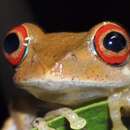Description
provided by AmphibiaWeb articles
A small brown treefrog. Males 25-30 mm, females larger (estimated size of one female 35 mm). Back brown often with more or less distinct transverse bars and numerous, very small, dispersed black spots. Flanks with numerous white spots, but without marks underneath tympanum or eye. Slightly developed white lateral folds along arm and tarsus. Skin on the back smooth. Venter creamish. Iris brown around the pupil, surrounded by red on the outer iris area. Iris periphery is blue. Nostrils are equidistant between the eye and tip of snout. Tympanum/eye ratio about 1/2. Tibiotarsal articulation reaches between nostril and tip of snout when hind limb is brought forward. Small dermal flaps or tubercles on the heel and elbow. Webbing of the hand: a trace of webbing between 1 and 2i and 2e and 3i, 3e(1.5), 4(1); webbing of the foot 1(0.75), 2i(1), 2e(0.5), 3i(1.5), 3e(0.5), 4i/e(1.5), 5(0.5). Males with nuptial pads and a slightly distensible, single subgular vocal sac. Specimens from Andringitra have a similar call but differ by a network of elevated ridges on the back, distinct black tubercles on the legs and a distinct white spot between eye and upper lip. Similar species: All juveniles of the Boophis goudoti-group; B. reticulatus, B. burgeri and B. sp. b are bigger (see Glaw and Vences 1992).
Nussbaum, R., Vallan, D., and Vences, M. (2008). Boophis boehmei. In: IUCN 2008. 2008 IUCN Red List of Threatened Species. www.iucnredlist.org. Downloaded on 08 April 2009.
- author
- Miguel Vences
- author
- Frank Glaw
Distribution and Habitat
provided by AmphibiaWeb articles
Ambohitantely, An’Ala, Andasibe, Ankeniheny. Exist at elevations in eastern Madagascar around 400-1,000m and in Ambohitantely around 1,500m. This species lives in rainforest and breeds in nearby streams (Nussbaum et al. 2008).
- author
- Miguel Vences
- author
- Frank Glaw
Life History, Abundance, Activity, and Special Behaviors
provided by AmphibiaWeb articles
Males call at night 1-2 m high from vegetation along brooks in primary forest. A pair was found in December. Call (from the terra typica): Composed of two different unharmonious notes. Note 1: duration 130-150 ms, consists of 10-19 pulses. Note 2: 30-50 ms, 4-6 pulses, mostly arranged in series of up to 8, with intervals between notes of 70-110 ms. Notes can be arranged as "1-2-2-2...", "2-2-2..." or "1-1-1.."; last variation has longer intervals between the notes. Frequency of both note types is between 2 and 3 kHz.Calls from Ankeniheny and Andringitra are similar. Eggs and tadpoles: Unknown.
- author
- Miguel Vences
- author
- Frank Glaw
Life History, Abundance, Activity, and Special Behaviors
provided by AmphibiaWeb articles
Least Concern: wide distribution and large population. All known sites are in protected areas (Nussbaum et al. 2008).
- author
- Miguel Vences
- author
- Frank Glaw
Boophis boehmei: Brief Summary
provided by wikipedia EN
Boophis boehmei is a species of frog in the family Mantellidae. It is endemic to Madagascar. Its natural habitats are subtropical or tropical moist lowland forests, subtropical or tropical moist montane forests, and rivers. It is threatened by habitat loss.
- license
- cc-by-sa-3.0
- copyright
- Wikipedia authors and editors

